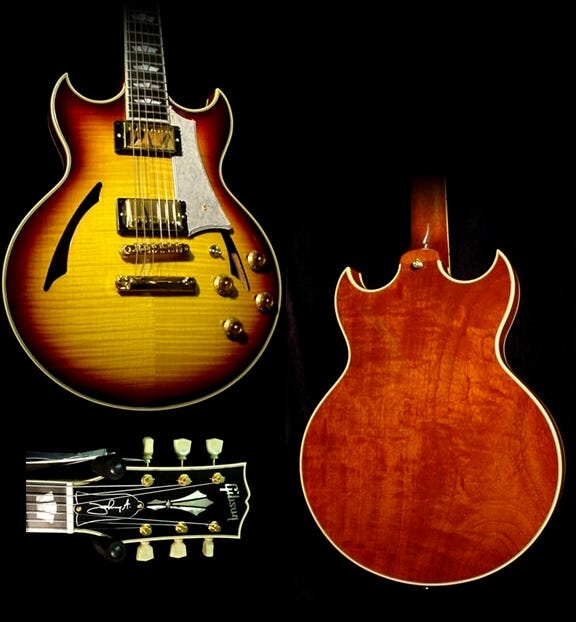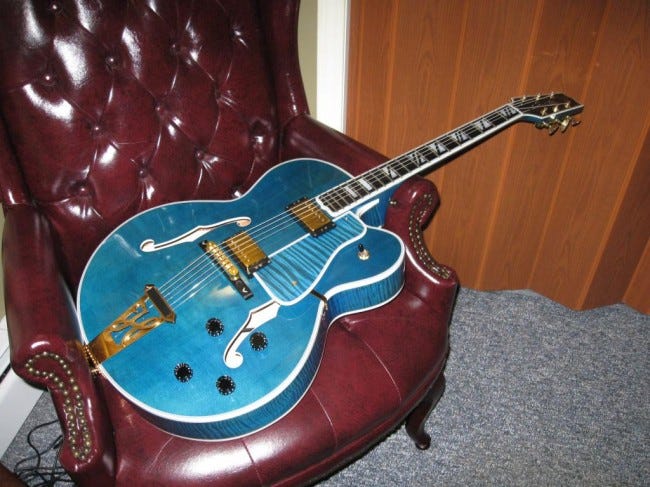You Are Not Needed Now

As a child, I thought of machines. I dreamed of cars and planes and spaceships and improbably steam-powered contraptions that worked brilliantly but never left their complete forms in my waking mind. I had no sympathy for people, no interest in their stories. I re-enacted famous naval battles using paper ships on my bedroom floor and consigned thousands to death with the serene indifference of a general officer in the Union Army.
Only lately has it occurred to me that every true, every worthwhile story is a story of people. That only the human element matters in the long run. So while this is, in theory, a short story of trading two guitars for another one, then changing my mind and trading yet again for a fourth, it's also a long story of people. A millionaire who died young and a craftsman who retired old. Four people who continued a tradition and one man who redefined it. Two aging middle-class men who have done tens of thousands' dollars worth of business on absolute trust. Most of all, it's about the hunger to collect, possess, trade, change. By 1984, Gibson Guitars had nearly completed their move from the historic old brick building in Kalamazoo, Michigan to Nashville, Tennessee. The $25/hour skilled unionized jobs in a cramped and dangerous old "soft-tooled" operation had been replaced by $8/hour right-to-work machine-minders in a modern, automated facility. The Kalamazoo plant had become a custom shop, a place to build the things the machines could not. This was wasteful. It was time for it to close. Come to Nashville, the employees were told. Earn the new wage, live in the new place. It doesn't snow. Things will be better.
Four men, senior people, leaders under the old brick smokestack and behind the broken windows, stayed behind. They were the oldest of the old hands, dating their employment to the magic halcyon days of the Fifties, to the 'Burst and the Korina Explorer and the instruments that change hands now for a million dollars in penthouses high above Tokyo. They adopted the headstock and the script of the oldest Gibsons and called themselves the Heritage Guitar Company. Every year, they turn out a few thousand guitars, mostly for overseas collectors who respect the old building and the old ways and the old men, who are now genuinely old; to be seventeen on the factory floor in 1957 means that you are seventy-three now. The hands that packed Jimmy Page's Les Paul into its case are now gnarled with age, even if they do not shake as they shape a mahogany guitar neck on a decades-old belt sander, using only their eyes and the memory burned into those hands.
Not all of the Heritage guitars go overseas. Some stay here. There is a group of collectors. I'm one of them; until this morning I owned fifteen Heritage Guitars. Perhaps twenty-five have passed through my hands. Two of them were built specifically for me by Marv Lamb, one of the four founders. One of them was presented to my son at the factory when he was two years old. He won't remember, but I do.
There is a fellow in this community of collectors. I've met him once, briefly. To preserve his privacy, I'll just call him the Doctor, with a nod to Neil Stephenson's Cryptonomicon. The Doctor only buys the very best. He has considerable resources, but more than that, he has an eye. He knows the story of Gibson and Heritage intimately, he knows the people, he separates wheat from chaff without sentiment. I understand he is a competent jazz-style guitarist, but I have never heard him play.
Some time ago, the Doctor became aware of a relatively rare thing: a natural-finish variant of Heritage's H-157 solidbody guitar, which is roughly equivalent to a Les Paul Custom. I'll let him tell the story after another photo:

The H157 was on [the Wolfe Guitars] site for a year or so. I kept trying to work [them] down to an affordable price (my opinion) every few months. Suddenly it was gone. A couple of months later a friend of mine from upstate NY asked if I'd be interested in his H157. When he sent me the pix I about fainted. It's a very well made H157. It sounds like a H157 should. It's average weight as I recall. And it is a looker.
I'd seen it as well, and I wanted it as well. Some guitars just have the look and this was one of them. By the time the Doctor bought this one, he and I had come to know each other pretty well. We'd done a few deals in the traditional method --- Paypal, verified addresses, the careful simultaneous exchanges of the online guitar market --- but by the time he decided he wanted to sell the H-157 we were to the point where we would simply throw a guitar in the mail to other fellow. "IF you decide you don't like it," the Doctor would say, "you can always send it back." A careful manipulation of this process on either of our parts might have put five thousand dollars in our pockets. But what is five thousand dollars compared to having someone you can trust with five thousand dollars?
So the H-157 arrived in the mail and I kept it. Around that time, I had a deal that didn't go nearly as well. It was for an H-170, the double-cut Heritage body style, and this is the guitar:

Another member of the collector community represented it to me as a perfect-condition, no-excuses guitar, which is explicitly was not. It was in excellent condition, but it was not "as new". I felt that I'd overpaid for it, but since I'd committed to buy it I went through with the transaction. This particular instrument had something else to recommend it: it was one of the very last Heritage "goldtops" to be sprayed by Floyd, the fellow who sprayed the original Les Paul Goldtops. It's possible that this one was painted by the same fellow who painted Muddy Waters' Les Paul --- or even Les Paul's Les Paul. Think of it: to paint guitars from one's youth all the way to one's old age, to have your work on the largest stages in the world and in the dumpster and the pawnshop and the museum, all at once. Floyd is retired now. You can still get a Heritage goldtop, but a link to the past has been irrevocably broken.

I decided to sell both of these guitars a few weeks ago, but I was too lazy/busy to get current photos taken and posted so I didn't get any bites to my extremely vague "For Sale, Maybe" post on the Heritage forum. Then the Doctor reached out to me. He knew both guitars; it turned out that he had owned the goldtop previously and that he'd sold it to the person from whom I bought it. He offered me a trade/cash deal that involved a Gibson "Johnny A":

Who's "Johnny A", you ask? That's what everyone asks. He's a career sideman jazz and rock guitarist who has a fair amount of credibility with the "corksniffer" guitar crowd. His signature model is built in the Memphis "Custom Shop" --- I've been there, it's a smaller operation than Gibon's Nashville operation but is still an automated operation full of CNC-milling machines --- and is extremely well-regarded. It's fair to say that Johnny A is most famous for having the Johnny A Signature Guitar, which is kind of an odd thing to say. But how many people under the age of fifty only know Les Paul as the name at the end of a guitar that Slash or Billie Jo or Chad Kroeger plays? Quite a few.
Although I already own a bright-red Gibson Memphis guitar, an ES-339 "Figured" that I bought in the lobby of Gibson Memphis on a particularly memorable and emotionally volcanic day, I was interested enough in the Johnny A to agree to make the deal. I packed and shipped my guitars this morning. And then I happened to see that the Doctor was selling another guitar for similar money:

What you see is probably the only "Chinery Blue" Super Eagle. The Super Eagle is Heritage's 18-inch-bodied "jazz box", the successor to the "Gibson Super 400" archtop that was developed and built in that Kalamazoo factory. The "Super 400" name, by the way, referred to the price: $400 in 1934, equivalent to $6900 today. A new Super Eagle lists for $7400. The Super 400 is still built by Gibson, in the Memphis shop, at prices ranging from $12,999 to $16,999 depending on configuration. It takes more time to build a Super Eagle than it does to build a Super 400; the Super Eagle is built entirely by hand, usually by one or two people, on the machines that Gibson abandoned thirty years ago, while the Super 400 is mostly machine-made and computer-perfected and sent out the door without ceremony.
What does "Chinery Blue" mean. Well, that's our final story. Scott Chinery was a six-foot-six monster of a fellow who sold nutritional supplements called "Cybergenics". He sold the company in 1984 and became hugely wealthy. He then pursued a few of his passions in extremis, including cigars (he reportedly owned over 11,000 "important" cigars) and guitars.
Chinery owned over a thousand guitars but he is best know for the "Blue Guitars", as seen in the video above. He commissioned twenty-two top luthiers to build blue full-sized archtop guitars. In doing so, he brought a huge amount of attention and respect back to the jazzbox, which frankly had been kind of an afterthought in guitar culture since around 1955 or thereabouts. Chinery died thirteen years ago at the age of 40, perhaps a victim of the steroids to which he'd promoted Cybergenics as a safe alternative. Eleven years after his death, the Met paid tribute to the man and his vision with the Guitar Heroes archtop exhibition. I happened to be lucky enough to see it in New York while it was there.
The Super Eagle that is on the way to me is not one of the 22 Chinery guitars; it just happens to be blue. Given that it was built in 1998, at the height of the "Blue Guitar" frenzy, the person who specified it almost certainly had that in mind, however.
I've owned two Heritage Eagles. The first one was more or less a gift from the Doctor to me; it was a nearly-new 16" Eagle Classic that had suffered a complete headstock break in shipping. On his request/recommendation I hired Aaron Cowles, the luthier who made the Gibson L-5 mandolins in Kalamazoo prior to the plant closure, to rebuild the guitar with a new neck. I've played it out in public several times since then. The second Eagle I had was a factory-second tobacco-colored Super Eagle that appeared at my local Guitar Center a few years ago. It was a beautiful guitar, and I played it with my brother at my 40th birthday party, but it wasn't the right Super Eagle, so I sold it.
This one, I'm hoping, is the right one. Inspired by a man who, by all accounts, knew he was dying even as he commissioned the Blue Guitars, hand-built by the men whose work made Gibson a worldwide name, and sent to me by a man who selects the very best. From here on out, the story is up to me.
* * *
The title of this post, which could be taken to refer to the guitars I traded, the men who retired from Heritage, or Chinery himself, is from the sorely missed Townes Van Zandt. Lay down your head a while / you are not needed now

